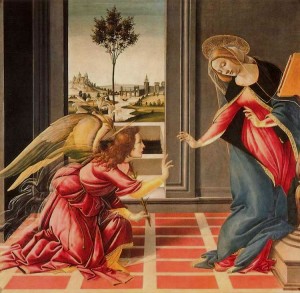From the Book of Revelation:
“I am the Alpha and the Omega”, says the Lord God, who is and who was and who is to come, the Almighty.
(From the Daily Office Lectionary – Rev. 1:8 (NRSV) – December 9, 2013.)
 First, a confession: I’m not fond of the Book of Revelation. Although it has occasionally brilliant passages and some incredible metaphoric imagery, it is probably the most abused and misused piece of scripture in the entire Christian canon! I remember hearing or reading at one time that, during the formation of the canon, bishops in what is now the Eastern Orthodox wing of the church opposed the inclusion of this book. If that had been the way things went, it would have been relegated to that collection of interesting historical literature which includes The Shepherd of Hermas, The Didiche, and the Letters of Clement. But it wasn’t, so we have it and we have to take it seriously. (When dealing with the Apocalypse, it is well to remember the meme about Episcopalians, though: “We take the Bible too seriously to take it literally!”)
First, a confession: I’m not fond of the Book of Revelation. Although it has occasionally brilliant passages and some incredible metaphoric imagery, it is probably the most abused and misused piece of scripture in the entire Christian canon! I remember hearing or reading at one time that, during the formation of the canon, bishops in what is now the Eastern Orthodox wing of the church opposed the inclusion of this book. If that had been the way things went, it would have been relegated to that collection of interesting historical literature which includes The Shepherd of Hermas, The Didiche, and the Letters of Clement. But it wasn’t, so we have it and we have to take it seriously. (When dealing with the Apocalypse, it is well to remember the meme about Episcopalians, though: “We take the Bible too seriously to take it literally!”)
One of the thinkers whose work was formative of my theology is the French Jesuit priest and paleontologist Pierre Teilhard de Chardin. He postulated the evolution of the universe in the direction of ever increasing complexity and ever growing consciousness. The supreme point of complexity and consciousness he dubbed “the Omega Point” (with reference to this verse, I wonder). He theorized that the Omega Point is utterly complex and completely conscious, transcendent, and independent of the universe; in fact, according to Teilhard, the Omega Point is the cause of the universe’s growth in complexity and consciousness. In a sense, it “invites” the creation to grow toward it. Teilhard argued that the Omega Point is equivalent to the Logos describe in the prologue to Gospel according to John, namely Christ, who draws all things into himself.
Most Christian theology focuses on God as the creator and source of all existence, the Alpha of this verse. As a result, we think of God as somehow “behind” creation; creation was perfect at the beginning, “fell” into brokenness, and now must somehow (through the grace of God) get back to that original state. But Teilhard’s thought invites us to focus on God as the goal and summation of all existence, a perfection to which we are evolving through God’s invitation.
There is an intersection between Teilhard’s thinking and another branch of theology that I found of value in my earlier studies, process theology derived from the philosophy of Alfred North Whitehead. One of the premises of process theology is that God does not control the universe, nor any individual in it, but rather influences our creaturely exercise of universal free will by offering possibilities. Note the plural! Possibilities! In other words, there are different ways to approach (getting back to Teilhard) the Omega Point.
Advent is the season of possibilities. One of the most powerful images of the season is Gabriel’s message to Mary, his communication to her of God’s invitation to be the mother of the Messiah. It is a moment fraught with possibility — she could have declined . . . . Sandro Botticelli’s painting of that liminal moment is poignant; the look on Gabriel’s face is one of almost-fear that she will refuse. Of course, she didn’t . . . and it would be an understatement to say that her life became one of increasing complexity!
As we look on that painting, as we consider God who is Alpha and Omega, both source and ending, who invites us into ever-increasing complexity and ever-growing consciousness, what are our possibilities? Where do we have opportunities to say “Yes” or “No” to God?
====================
A request to my readers: I’m trying to build the readership of this blog and I’d very much appreciate your help in doing so. If you find something here that is of value, please share it with others. If you are on Facebook, “like” the posts on your page so others can see them. If you are following me on Twitter, please “retweet” the notices of these meditations. If you have a blog of your own, please include mine in your links (a favor I will gladly reciprocate). Many thanks!
====================
Father Funston is the rector of St. Paul’s Episcopal Church, Medina, Ohio.



Leave a Reply